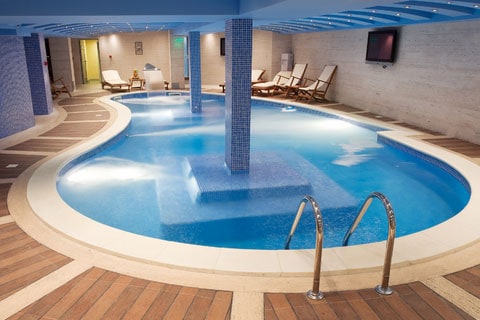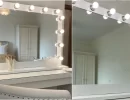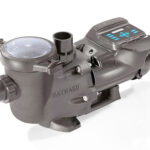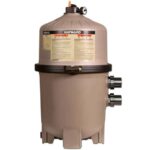An expert buying guide for swimming pool lighting, which covers the different lighting types including LED, fiber optic, solar, floating, and traditional.
Having an adequate amount of lighting in and around your pool is a necessity if you plan to use the pool at night. Adding lights to a pool area is also a chance to add a bit of ambiance. The most popular choices are LED, fiber- optic, and floating lights, which include solar lights.
LED Pool Lights
Pool owners are increasingly replacing their built-in incandescent lights with LED lights. Considered an environmentally friendly option, LED lights are very bright and last a long time– typically 30,000 hours versus about 5,000 for the old-fashioned incandescent bulbs. LEDs cost a little more but are cheaper in the long run. Plus, they use no environmentally objectionable substances.
A number of different options are available for either above or below the water surface. The latest rage is lighting that changes colors. These lights have a color wheel built into them with a number of options you can program. For instance, you might push a button to select a color and then sinply push it again to get another color. Or, you might push a button several times to “scroll through” the colors to create a light show in your pool.
Fiber-Optic Lights
These can create an appealingly starry effect on the floor of your pool or around its rim. Fiber optics are not as bright as LED lights so you need several strands to produce enough light for nighttime safety.
Fiber-optic cable has no electricity running through it so the lights are totally safe in the water. The cables run to a generating box located away from the pool. There, the light that is generated is beamed through the cable strands. One box will have a certain strand capacity, typically for several cables. Installation is fairly straightforward for a do-it-yourselfer.
Floating Lights
These lights are an easy and inexpensive option for adding light to a pool. They run on rechargeable batteries and are available in a range of styles and colors. Some project light upward; others project light down to make the pool look like a disco of circle lights. They can float freely or be tethered to stay where you want them. Floating lights are also available in solar versions.
Solar Lights
Like floating lights, solar lights use a rechargeable battery, but instead of being wired they use a solar collector on top of the light’s waterproof case to collect sunlight, which recharges the battery sealed inside. Solar lights are usually not as bright as other lights, and after a spell of cloudy weather they will not shine for long. But manufacturers are improving them all the time, so check with your supplier to see if solar will meet your needs.
Solar lights are available in a variety of shapes, sizes, and colors and usually come with a built-in light sensor to automatically turn on at night. If you want to turn them off you must do so individually and manually; you cannot hook up a switch to turn off a number of them simultaneously. (If you want the ability to shut them off, make sure you buy those with switches as not all solar lights have them.
Traditional Pool Lights
These are the familiar lights you’ve seen at public swimming pools—an incandescent or quartz halogen bulb nested inside the wall of the pool in a sealed case. Nowadays, they are more reliable and have a better waterproof seal. They are usually installed when the pool is built.
Changing the bulb is a bit of a hassle as it involves pulling the light out of its niche (it has a long cord) and bringing it to the surface to replace the old bulb. If you’re adding new lights to an old pool, check with your building department to be sure you’re meeting safety regulations.








 Don Vandervort writes or edits every article at HomeTips. Don has:
Don Vandervort writes or edits every article at HomeTips. Don has:




